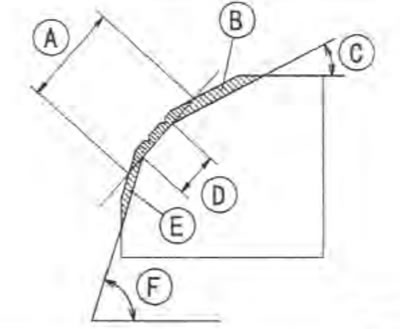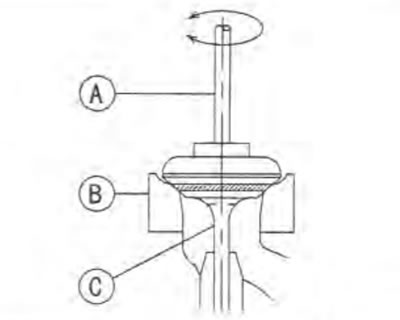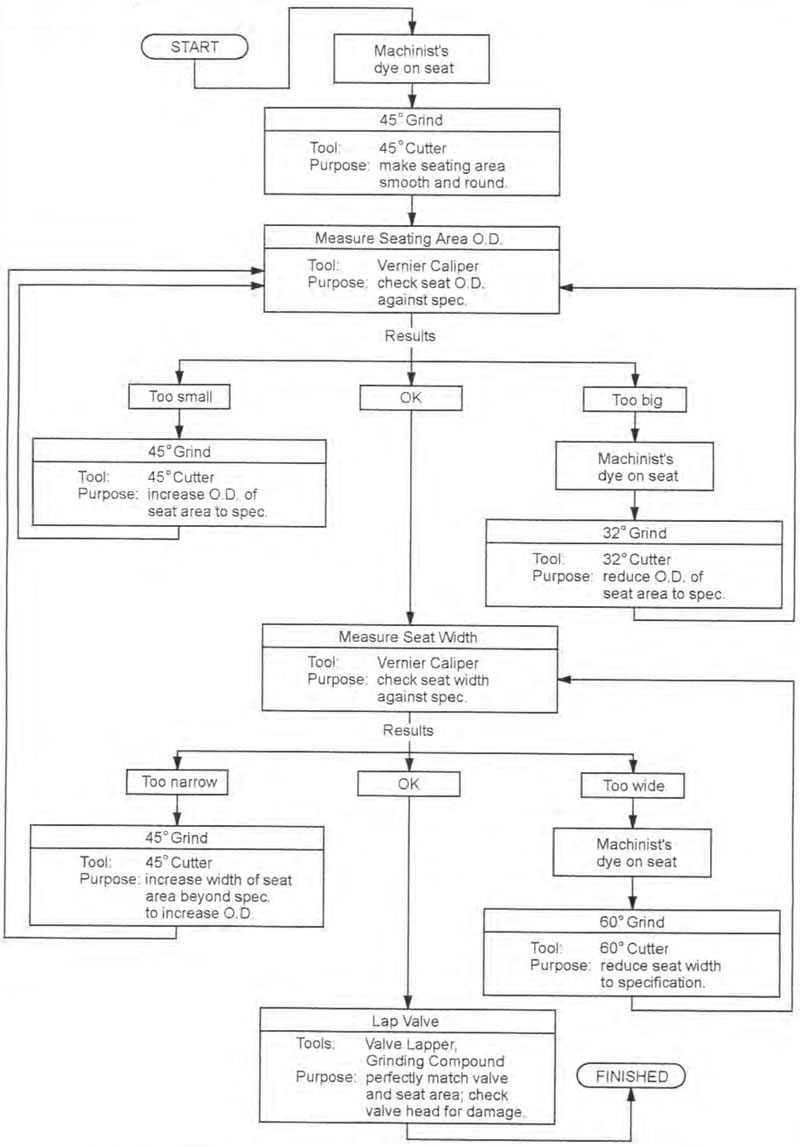
Special Tool:
- Valve Seat Cutter Holder, 04: 57001-1275 [B]
- Valve Seat Cutter Holder Bar: 57001-1128 [C]
[For Inlet Valve Seat]
- Valve Seat Cutter, 45° - ∅24: 57001-1113
- Valve Seat Cutter, 32° - ∅25: 57001-1118
- Valve Seat Cutter, 60° - ∅25: 57001-1328
[For Exhaust Valve Seat]
- Valve Seat Cutter. 45° - ∅27.5: 57001-1114
- Valve Seat Cutter, 32° - ∅28: 57001-1119
- Valve Seat Cutter. 60° - ∅27: 57001-1409
★ If the manufacturer's instructions are not available, use the following procedure.
Seat cutter operation care
1. This valve seat cutter is developed to grind the valve for repair. Therefore the cutter must not be used for other purposes than seat repair.
2 Do not drop or shock the valve seat cutter, or the diamond particles may fall off.
3 Do not fail to apply engine oil to the valve seat cutter before grinding the seat surface. Also wash off ground particles sticking to the cutter with washing oil.
Note. Do not use a wire brush to remove the metal particles from the cutter. It will take off the diamond particles.
4. Setting the valve seat cutter holder in position, operate the cutter in one hand. Do not apply too much force to the diamond portion.
Note. Prior to grinding, apply engine oil to the cutter and during the operation, wash off any ground particles sticking to the cutter with washing oil.
5. After use, wash it with washing oil and apply thin layer of engine oil before storing.
Marks stamped on the cutter
The marks stamped on the back of the cutter [A] represent the following.
- 60° — Cutter angle [B]
- ∅37.5 — Outer diameter of cutter [C]

Operating procedures
Clean the seat area carefully.
Coat the seat with machinist’s dye.
Fit a 45° cutter into the holder and slide it into the valve guide.
Press down lightly on the handle and turn it right or left. Grind the seating surface only until it is smooth.
Caution! Do not grind the seat too much. Overgrinding will reduce valve clearance by sinking the valve into the head. If the valve sinks too far into the head, ft will be impossible to adjust the clearance, and the cylinder head must be replaced.
Measure the outside diameter of the seating surface with a vernier caliper.
★ If the outside diameter of the seating surface is too small, repeat the 45 grind until the diameter is within the specified range.
- Widened Width [A] of engagement by machining with 45° cutter
- Ground Volume [B] by 32° cutter
- 32° [C]
- Correct Width [D]
- Ground Volume [E] by 60° cutter
- 60° [F]

Measure the outside diameter of the seating surface with a vernier caliper.
★ if the outside diameter of the seating surface is too small, repeat the 45° grind [A] until the diameter is within the specified range.

Original Seating Surface [B].
Note.
- Remove all pittings of flaws from 45° ground surface.
- After grinding with 45° cutter, apply thin coat of machinist's dye to seating surface. This makes seating surface distinct and 32° and 60° grinding operation easier.
- When the valve guide is replaced, be sure to grind with 45° cutter for centering and good contact.
★ If the outside diameter of the seating surface is too large, make the 32° grind described below.
If the outside diameter [A] of the seating surface is within the specified range, measure the seat width as described below.

Grind the seat at a 32° angle [B] until the seat O.D. is within the specified range.
To make the 32° grind, fit a 32° cutter into the holder, and slide it into the valve guide.
Turn the holder one turn at a time while pressing down very lightly. Check the seat after each turn.
Caution! The 32° cutter removes material very quickly. Check the seat outside diameter frequently to prevent overgrinding.
О After making the 32° grind, return to the seat O.D. measurement step above.
To measure the seat width, use a vernier caliper to measure the width of the 45° angle portion of the seat at several places around the seat.
★ If the seat width is too narrow, repeat the 45° grind until the seat is slightly too wide, and then return to the seat O.D. measurement step above.
★ If the seat width is too wide, make the 60° [A] grind described below.

★ If the seat width is within the specified range, lap the valve to the seat as described below.
Grind the seat at a 60° angle until the seat width is within the specified range.
To make the 60° grind, fit 60° cutter into the holder, and slide it into the valve guide.
Turn the holder, while pressing down lightly.
After making the 60° grind, return to the seat width measurement step above.
Correct Width [B].
Lap the valve to the seat, once the seat width and O.D. are within the ranges specified above.
Put a little coarse grinding compound on the face of the valve in a number of places around the valve head.
Spin the valve against the seat until the grinding compound produces a smooth, matched surface on both the seat and the valve.
Repeat the process with a fine grinding compound.
- [A] Lapper
- [B] Valve Seat
- [C] Valve

The seating area should be marked about in the middle of the valve face.
★ If the seat area is not in the right place on the valve, check to be sure the valve is the correct part. If it is, it may have been refaced too much; replace it.
Be sure to remove all grinding compound before assembly.
When the engine is assembled, be sure to adjust the valve clearance (see Valve Clearance Adjustment).

Valve seat repair
